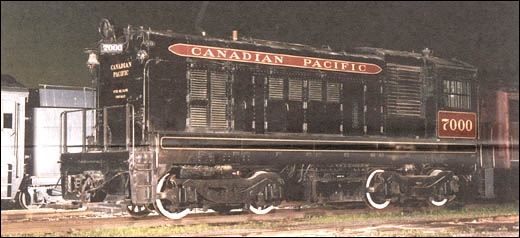
|
VOLUME THIRTY-ONE
|
NUMBER FOUR 2001
|
CPR's First Diesel-Electric
Locomotive:
No. 7000

 CPR was a late-comer to the diesel-electric scene.
CPR was a late-comer to the diesel-electric scene.
By the time CPR decided to dabble in this new technology, it was already 1935. Some Class I railways in North
America had taken the plunge in the 1920s. Standardized diesel-electric designs were available in
the U.S. in 1924.
Canadian National Railways was already testing and operating diesel-electric switcher and road
locomotives in 1928 and 1929. And General electric had produced three experimental
diesel-electric switcher locomotives as early as 1918 - one being an armored locomotive for the
U.S. Army to use in the First World War.
CPR, known at the time for its cautious, if not conservative approach to motive power policy, opted to order
and test a prototype diesel-electric locomotive in the midst of its steam motive power heyday.
Henry Blaine Bowen, CPR's last motive power chief to acquire steam motive power, loaded up the company with
462 steam locomotives during his 21-year tenure that ended in 1949.
Though his heart was clearly captivated by the steam locomotive he knew so well, he agreed, somewhat
reluctantly, to try out this first new diesel-electric technology. In the April 1935 issue of the
company's Staff Bulletin, Bowen made a prediction that ensured his place in history - on the blooper
roll: "The diesel engine of today, as wonderful as it is, is doubtful as a lasting standard and it
seems a reasonable prediction that it will be considered obsolete in a short period of years".
Despite his prediction, that same year CPR ordered a diesel-electric switcher locomotive
prototype from Montreal's Stone Franklin of Canada.
National Steel Car Company, a purveyor to this day of CPR freight cars, built the locomotive in its plant in
Hamilton, Ontario. The experimental locomotive got its diesel power plant from the famed Irish marine engine
suppliers who, amongst other well-known ships, powered the Titanic.
Harland and Wolff produced a 622PR railway-traction type, two-cycle,
in-line, six-cylinder, 550-h.p. diesel engine to power the locomotive.
The locomotive's top speed was 30 mph (48 kph). The electrical design and equipment came from Laurence Scott
and Electromotors of Norwich, England. And the electrical system used a modified Ward Leonard control system.
This control system had a peculiar six-position throttle, with only two power positions (4 and
5):
1 - Off
2 - Stop
3 - Idling
4 - Second Speed
5 - Full Speed
6 - Battery Topping.
No. 7000, delivered in November 1937, spent its entire seven-year CPR career in Montreal as a
yard switcher. Even before the seven-year trail period was up, diesel-electric
motive power had proven itself to CPR's research and mechanical staff, at least in yard switching
applications.
CPR took delivery of its first five production diesel-electric switchers in 1943 and assigned
them to Montreal. And before the company sold its experimental switcher, 6 Oct 1944, to Marathon
Pulp and Paper, CPR took delivery of five more S-2 Alco switchers for its yards in Winnipeg and
Calgary. CPR's yards in Toronto would get their first five 1,000-h.p., S-2
diesel-electric switchers within days of No. 7000's sale to its Ontario pulp and paper customer.
No. 7000 was re-engined with a Caterpillar power plant in 1951.
Marathon Pulp and Paper donated No. 7000 to the Canadian Railroad Historical Association (CRHA) in 1964. The
CRHA restored the locomotive to its original Canadian Pacific livery and now displays the milestone
locomotive at its Canadian Railway Museum in St. Constant, Quebec.
| |
Vital
Statistics
|
Number
|
7000
|
Class
|
None
|
Builder
|
National Steel Car
|
Outshopped
|
Nov 1937
|
Builder's Model
|
None
|
Horsepower
|
550
|
Cylinders
|
6
|
Axles
|
4
|
Maximum speed
|
30 mph (48 kph)
|
Weight
|
245,000 lbs. (111,132 kg)
|
Purchase price
|
$89,500.
|
This Canadian Pacific
Railway News article is copyright 2001 by the Canadian Pacific Railway and is reprinted here
with their permission. All photographs, logos, and trademarks are the property of the Canadian Pacific Railway
Company.
|
|